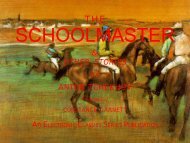The Souls of Black Folk - Dr. Earl Wright II
The Souls of Black Folk - Dr. Earl Wright II
The Souls of Black Folk - Dr. Earl Wright II
- No tags were found...
You also want an ePaper? Increase the reach of your titles
YUMPU automatically turns print PDFs into web optimized ePapers that Google loves.
W. E. B. Du Boisment <strong>of</strong> a people, their attitude is largely one <strong>of</strong> determined oppositionto and conquest <strong>of</strong> natural forces. But when to earth andbrute is added an environment <strong>of</strong> men and ideas, then the attitude<strong>of</strong> the imprisoned group may take three main forms,—a feeling <strong>of</strong>revolt and revenge; an attempt to adjust all thought and action tothe will <strong>of</strong> the greater group; or, finally, a determined effort at selfrealizationand self-development despite environing opinion. <strong>The</strong>influence <strong>of</strong> all <strong>of</strong> these attitudes at various times can be traced inthe history <strong>of</strong> the American Negro, and in the evolution <strong>of</strong> his successiveleaders.Before 1750, while the fire <strong>of</strong> African freedom still burned in theveins <strong>of</strong> the slaves, there was in all leadership or attempted leadershipbut the one motive <strong>of</strong> revolt and revenge, —typified in theterrible Maroons, the Danish blacks, and Cato <strong>of</strong> Stono, and veilingall the Americas in fear <strong>of</strong> insurrection. <strong>The</strong> liberalizing tendencies<strong>of</strong> the latter half <strong>of</strong> the eighteenth century brought, along withkindlier relations between black and white, thoughts <strong>of</strong> ultimateadjustment and assimilation. Such aspiration was especially voicedin the earnest songs <strong>of</strong> Phyllis, in the martyrdom <strong>of</strong> Attucks, thefighting <strong>of</strong> Salem and Poor, the intellectual accomplishments <strong>of</strong>Banneker and Derham, and the political demands <strong>of</strong> the Cuffes.Stern financial and social stress after the war cooled much <strong>of</strong> theprevious humanitarian ardor. <strong>The</strong> disappointment and impatience<strong>of</strong> the Negroes at the persistence <strong>of</strong> slavery and serfdom voiced itselfin two movements. <strong>The</strong> slaves in the South, aroused undoubtedlyby vague rumors <strong>of</strong> the Haytian revolt, made three fierce attemptsat insurrection,—in 1800 under Gabriel in Virginia, in 1822under Vesey in Carolina, and in 1831 again in Virginia under theterrible Nat Turner. In the Free States, on the other hand, a newand curious attempt at self-development was made. In Philadelphiaand New York color-prescription led to a withdrawal <strong>of</strong> Negro communicantsfrom white churches and the formation <strong>of</strong> a peculiarsocio-religious institution among the Negroes known as the AfricanChurch,—an organization still living and controlling in its variousbranches over a million <strong>of</strong> men.Walker’s wild appeal against the trend <strong>of</strong> the times showed howthe world was changing after the coming <strong>of</strong> the cotton-gin. By 183039
















